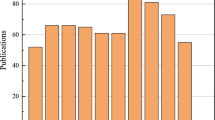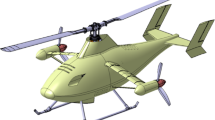Abstract
The aim of this study is to increase the dynamic stability of the quadrotor unmanned aerial vehicles in varying structural parameters. The qualitative analysis is considered the main method for analyzing the dynamic stability, while the index of qualitative analysis of the structural stability and the dynamic stability is still hard to establish. Therefore, the process during takeoff, pitching, or yawing is selected for investigating in the present papers, the method of Lyapunov exponent is adopted for establishing the quantification relationship between structural parameters of the quadrotor unmanned aerial vehicles and dynamic stability, which provides for guiding the design of the vehicle’s mechanical structure and the optimization of its stability control by using the relationship. As compared to its counterpart of Lyapunov’s second method, the main advantage of the concept of Lyapunov exponents is that the methods for calculating the exponent process are constructive which makes the stability analysis of complex nonlinear systems possible.
Similar content being viewed by others
References
Wolf A, Swift JB, Swinney HL, Vastano JA (1985) Determining Lyapunov exponents from a time series. Physica 16D:285–317 North-Holland, Amsterdam
Alligood KT, Sauer TD, Yorke JA (1997) Chaos, an introduction to dynamical systems. Springer, New York
Williams GP (1997) Chaos theory tamed. Joseph Henry Press, Washington, D.C
Sekhavat P, Sepehri N, Wu Q (2004) Calculation of Lyapunov exponents using nonstandard finite difference discretization scheme: a case study. J Differ Equ Appl 10(4):369–378 http://www.tandfonline.com/loi/gdea20
Dingwell JB (2000) Nonlinear time series analysis of normal and pathological human walking. Chaos 10:848–863
Kinsner W (2006) Characterizing chaos through Lyapunov metrics. IEEE Trans Syst Man Cybern Part C Appl Rev 36(2):141–151
Müller PC (1995) Calculation of Lyapunov exponents for dynamic systems with discontinuities. Chaos, Solitons Fractals 5(9):1671–1681
Oseledec VI (1968) A multiplicative ergodic theorem: Lyapunov characteristic numbers for dynamical systems. Trans Mosc Math Soc 19:197
Asokanthan SF, Wang XH (1996) Characterization of torsional in stability in a hooke’s joint driven system via maximal Lyapunov exponents. J Sound Vib 194(1):83–91
Gilat R, Aboudi J (2000) Parametric stability of non-linearly elastic composite plates by Lyapunov exponents. J Sound Vib 235(4):627–637. doi:10.1006/jsvi.2000.2936
Zevin AA, Pinsky MA (2005) Absolute stability criteria fora generalized Lur’e problem with delay in the feedback. SIAM J Control Optim 43(6):2000–2008. doi:10.1137/S0363012903437599
Awrejcewicz J, Kudra G (2005) Stability analysis and Lyapunov exponents of a multi-body mechanical system with rigid unilateral constraints. Nonlinear Anal 63:909–918 Available online at www.sciencedirect.com
Rogelio C, Gustavo A, Javier CP (2004) Determination of limit cycles using both the slope of correl ationintegral and dominant Lyapunov methods. Nucl. Technol 145(2):139–149
Wu Q, Sekhavat P, Sepehri N, Peles S (2005) On design of continuous Lyapunov’s feedback control. J Frankl Inst 342:702–723 Available online at www.sciencedirect.com
Sekhavat P, Sepehri N, Wu Q (2006) Impact control for hydraulic actuators with friction: theory and experiments. Control Engineering Practice 14(12): 1423–1433. www.elsevier.com/locate/conengprac
Masoud P (2016) Simultaneous application of time series analysis and wavelet transform for determining surface roughness of the ground workpieces. Int J Adv Manuf Technol 85:1793–1805. doi:10.07/s00170-015-8008-z
Omar N, Ghada B, Abderrazak O (2015) Global stabilization of an adaptive observer-based controller design applied to induction machine. Int J Adv Manuf Technol 81:423–432. doi:10.07/s00170-015-7099-x
Bai YQ, Liu H, Shi ZY (2012) Robust flight control of quadrotor unmanned air vehicles. Robot 34(5):519–524. doi:10.3724/SP.J.1218.2012.00519
Amiri N, Ramirez-Serrano AR, Davies J (2013) Integral back stepping control of an unconventional dual-fan unmanned aerial vehicle. J Intell Robot Syst 69:147–159. doi:10.1007/s10846-012-9744-z
Shimada I, Nagashima T (1979) A numerical approach to ergodic problem of dissipative dynamical system. Prog Theor Phys 6l(6):1605–1616. doi:10.1143/PTP.61.1605
Shimada I, Nagashima T (2002) Chaos phenomena in 2-link manipulator with dead time and its control. SICE 2002. Proceedings of the 41st SICE Annual Conference 4:2255–2258 doi 10.1109/SICE.2002.1195751
Benettin G, Galgani L, Strelcyn JM (1980) Lyapunov characteristic exponents for smooth dynamical systems and for Hamiltonian systems; a method for computing all of them. Theory, Meccanica 15(7):9–20
Author information
Authors and Affiliations
Corresponding author
Rights and permissions
About this article
Cite this article
Liu, Y., Chen, C., Wu, H. et al. Structural stability analysis and optimization of the quadrotor unmanned aerial vehicles via the concept of Lyapunov exponents. Int J Adv Manuf Technol 94, 3217–3227 (2018). https://doi.org/10.1007/s00170-016-9311-z
Received:
Accepted:
Published:
Issue Date:
DOI: https://doi.org/10.1007/s00170-016-9311-z




